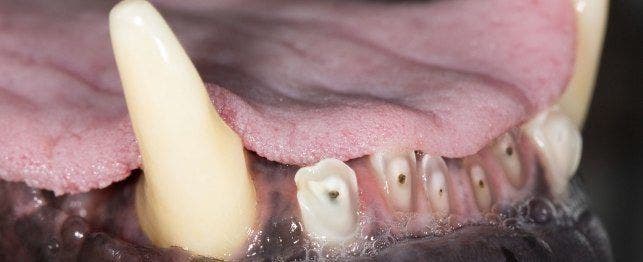
Attrition (Worn Teeth) in Dogs
Overview of Canine Attrition (Worn Teeth)
As dogs age, all that chewing they have done through their lives catches up with them and the teeth begin to show signs of wear. This is particularly common in the incisors of older dogs. Even though some tooth wear is common and to be expected, there are times when tooth wear is excessive. Attrition is the word used to describe an abnormally rapid loss of the top of the tooth (crown).
The most common cause of attrition is a tendency to excessively chew objects or misaligned teeth. Dogs with an untreated itchy skin disorder will often continuously chew at themselves, eventually resulting in significant attrition.
When the enamel is gradually worn down, the body will produce and lay down dentin, to protect the tooth pulp from exposure. This dentin appears as a dark brown spot in the middle of the tooth, covering the pulp. When attrition occurs (rapid wear), the pulp may be exposed since there is not sufficient time for the dentin to be produced.
What to Watch For
Signs of worn teeth in dogs may include:
- Teeth that are worn down
- Very short teeth with the dental pulp cavity exposed
- Possible oral pain
Diagnosis of Worn Teeth in Dogs
The most important part of diagnosing attrition is to determine if the pulp cavity has been exposed. To do this, a dental explorer is used. If a defect in the central brown area is detected, the pulp has been exposed. In normal tooth wear, the dentin is strong and smooth. It covers the top of the tooth and the dental explorer cannot enter the tooth.
Treatment of Attrition (Worn Teeth) in Dogs
If the dentin adequately covers and protects the affected teeth, no treatment is necessary. If the pulp has been exposed, root canal or tooth removal is recommended. Preventing continued chewing will help reduce additional wear.
Home Care and Prevention
The goal of home care and prevention is to prevent your dog from excessively chewing on items. Itchy skin disorders should be promptly treated. Do not allow your dog to obsessively chew on hard objects such as wood, rocks, fencing, etc. (This is a long-term problem and does not include the normal chewing behavior of puppies.)
Routine dental care, including tooth brushing, can help keep the mouth healthy and will help you periodically examine your pet’s teeth, looking for potential problems.